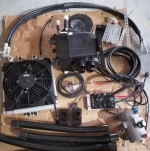I am initiating this thread on behalf of the new owner of a 1974 DS23 Pallas BW35 automatic (carby) sedan which was delivered to its original owner in Adelaide in September 1975 and spent the ensuing 45+ years in South Australia. I owned the car for 26 years prior to its recent sale to Michael, a resident of Singapore.
When I purchased the car, it was fitted with what I understand was a typical air conditioning system of the era: block-mounted York compressor; twin, fan-cooled condensers, mounted in the front wheel valances behind the ventilated front bumper bar and evaporator and controls mounted in a locally-fabricated shroud located under the standard ventilation controls.
I removed the air conditioner soon after purchasing the car, mainly because I only drove the car in mild weather and I didn't like the concept of driving the compressor via the camshaft.
I have never been to Singapore, but I understand its weather is generally more 'extremely tropical' than the most tropical parts of Australia; hence, Michael is contemplating 're-air conditioning' his 'new' D and he would welcome Forum members' suggestions on how best to tackle this, employing modern technology, notwithstanding that the subject vehicle is a DS23 auto approaching 50 years of age. I should add that I believe there are very few Ds in Singapore and very few mechanically-minded people conversant with them, but, I understand, no shortage of air conditioning specialists.
Michael has authorised my initiation of this thread and I expect he will contribute posts as appropriate as the conversation evolves.
Thank you, in anticipation.
Chris
When I purchased the car, it was fitted with what I understand was a typical air conditioning system of the era: block-mounted York compressor; twin, fan-cooled condensers, mounted in the front wheel valances behind the ventilated front bumper bar and evaporator and controls mounted in a locally-fabricated shroud located under the standard ventilation controls.
I removed the air conditioner soon after purchasing the car, mainly because I only drove the car in mild weather and I didn't like the concept of driving the compressor via the camshaft.
I have never been to Singapore, but I understand its weather is generally more 'extremely tropical' than the most tropical parts of Australia; hence, Michael is contemplating 're-air conditioning' his 'new' D and he would welcome Forum members' suggestions on how best to tackle this, employing modern technology, notwithstanding that the subject vehicle is a DS23 auto approaching 50 years of age. I should add that I believe there are very few Ds in Singapore and very few mechanically-minded people conversant with them, but, I understand, no shortage of air conditioning specialists.
Michael has authorised my initiation of this thread and I expect he will contribute posts as appropriate as the conversation evolves.
Thank you, in anticipation.
Chris

